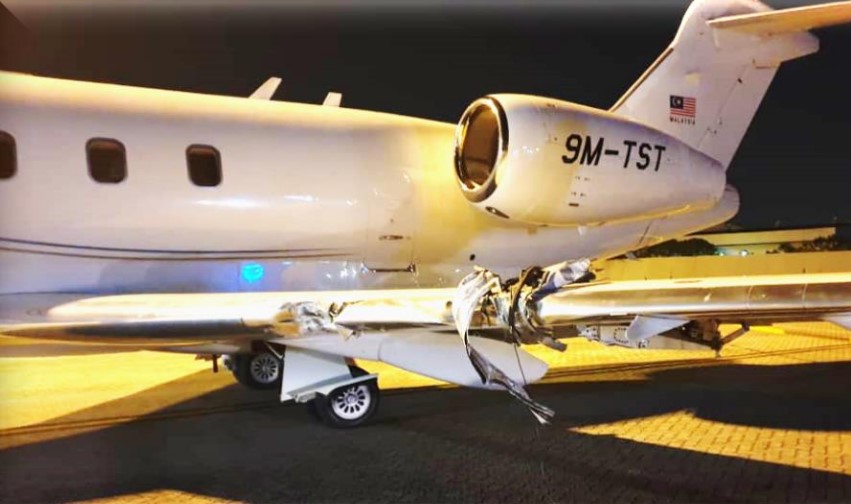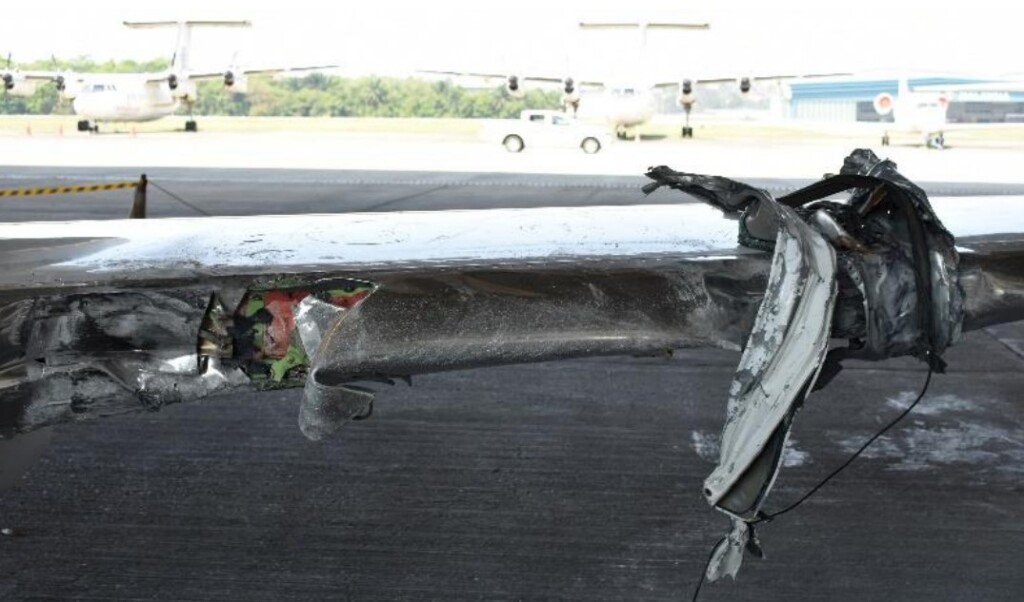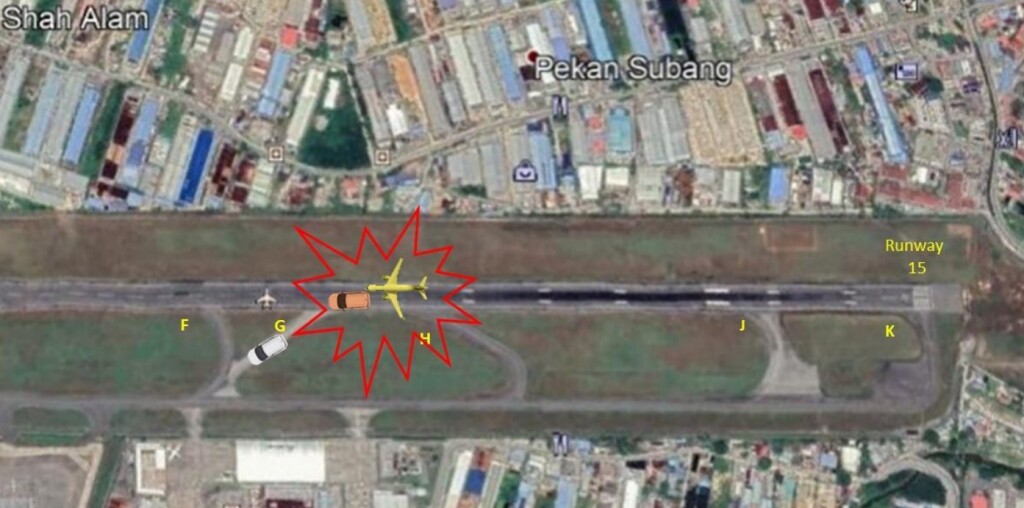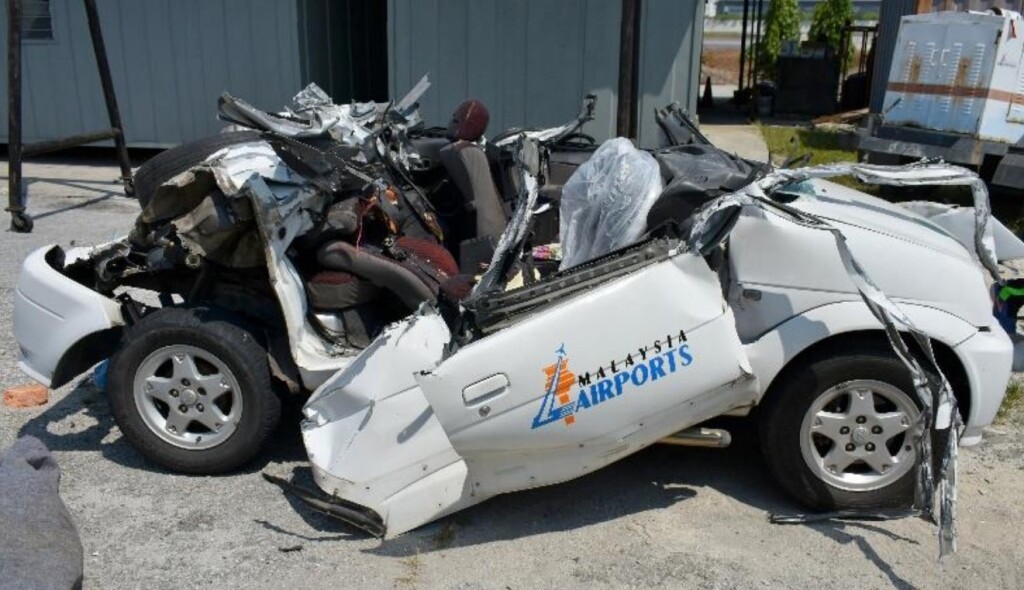Fatal ATC Handover: Challenger 300 9M-TST Collides with an Airport Vehicle on Landing at Kuala Lumpur-Sultan Abdul Aziz Shah Airport (Subang)
On 18 March 2019 Bombardier BD-100-1A10 Challenger 300 9M-TST of Berjaya Air, with 12 persons on board, was damaged when it struck an engineering vehicle when landing at night at Kuala Lumpur-Sultan Abdul Aziz Shah Airport (Subang) (SZB). The driver of the vehicle died later in hospital due to head injuries.

Berjaya Air Bombardier BD-100-1A10 Challenger 300 9M-TST After Collision with Vehicle Landing at Kuala Lumpur-Sultan Abdul Aziz Shah Airport (Credit: Malaysian AAIB)
The Malaysian Air Accident Investigation Bureau (AAIB) explain in their safety investigation report (issued 2 December 2021) that the aircraft had made an ILS approach and touched down at 03:11 Local Time and was decelerating through 100 knots when the aircraft commander felt an impact.
The aircraft stopped on a taxiway and the cabin crew confirmed that they could see damage to the wing. The aircraft commander the proceeded to taxi to their stand. No one onboard was injured.
On inspection there was significant damage to the left hand wing with embedded debris from the Perodua Kembara SUV that was hit.

Damage to Left Wing of Berjaya Air Bombardier BD-100-1A10 Challenger 300 9M-TST After Collision with Vehicle Landing at Kuala Lumpur-Sultan Abdul Aziz Shah Airport (Credit: Malaysian AAIB)
The SUV was found 1200 m from the runway threshold by the airport fire crew.

AAIB Representation of Berjaya Air Bombardier BD-100-1A10 Challenger 300 9M-TST Collision with Vehicle at Kuala Lumpur-Sultan Abdul Aziz Shah Airport (Credit: Malaysian AAIB)
Its roof was ripped off and the the driver was trapped inside.

Escort Vehicle after Berjaya Air Bombardier BD-100-1A10 Challenger 300 9M-TST Collided with it on Landing at Kuala Lumpur-Sultan Abdul Aziz Shah Airport (Credit: Malaysian AAIB)
The AAIB Safety Investigation
The SUV had been escorting a runway painting vehicle (with three occupants) that had been authorised to enter the runway at 01:00 Local Time to paint centre line markings, 10 minutes after a separate electrical working party had been cleared to conduct runway lighting work.
The Duty Air Traffic Controller had radio communications with the escort vehicle not the painting contractors vehicle. There were two controller shift changes:
However, in the handover between ATC shifts at 03:00 Local Time there was no mention of ongoing work. Although there was a written record of the work commencing, when the electrical working party left the runway at 02:15 Local Time the log recorded that all vehicles were clear.
The team leader on the painting vehicle did see the landing lights of the business jet on approach.
Fearing of the danger, all three workers boarded their vehicle and drove away from the runway. While making a 180 degrees turn, the driver realised the escorting vehicle was still static [about 120 m away]. …they flashed the headlights of their vehicle several times to attract the escort vehicle attention. No response was observed from the escort vehicle, and as the aircraft was getting closer to them, the [painting vehicle] driver drove…away from the runway and stop[ped] at taxiway Foxtrot to give way for the aircraft to land.
The escort vehicle (only) was fitted with an amber flashing light. Neither the ATCO nor the flight crew saw the light which the painting crew confirm had been on. It was also not visible when CCTV footage was examined. As the light was destroyed the investigators could not determine its intensity or whether it was still operating at impact.
The investigators explain that:
ATC services [are] provided by Civil Aviation Authority of Malaysia (CAAM). The Aerodrome Control consist of Tower Supervisor, Aerodrome Control, Surface Movement Control, Assistant Surface Movement Control and Assistant Tower/Coordinator. During the time range of before and after the accident, Aerodrome Control manning have been reduced to one controller per shift for one and a half hour on each rotation from 0001hrs until 0600hrs in a system named as “Break Shift”. The “Break Shift” roster divided among the four controllers rostered for the night shift. Break Shift is not published in any document as an approved ATC Tower manning system.
Malaysia Airports Sdn. Bhd. is the organisation responsible for the maintenance of the airport such as the runway lighting, runway marking and other facilities within SAAS Airport, Subang. All maintenance works for the runway needs to be coordinated between MASB and Control Tower.
Malaysian AAIB Probable Cause
Incorrect information of vehicle activities on the runway handed over to the taking over controller led to the landing clearance given without realising the runway is occupied.
Malaysian AAIB Safety Recommendations
- CAAM is to ensure the shift manning especially during low traffic density is to take into consideration of human fatigue as recommended in the ICAO Doc 9966 – The Manual for the Oversight of Fatigue Management Approaches. Any amendment or changes of shift manning need to be officially published.
- MASB and CAAM need to coordinate an effort to ensure that the means of communication between ground vehicle operating within the manoeuvring area and Air Traffic Controller is in accordance to ICAO Doc 9870 – Manual on The Prevention of Runway Incursion, Chapter 4, Paragraph 4.2.6 which require the use of VHF radio.
- MASB and CAAM is suggested to have a specific Chapter or Annexes in the existing SOP listing down the specification of vehicle to be used for manoeuvring area including vehicle accessories which need to be installed. For example, the intensity of beacon light to be used on vehicles, coordination phraseology between ATC and driver etcetera. Civil Aviation (Aerodrome Operations) Regulation 2016 stated in Paragraph 40 (1) (d) (ii) only specify “all vehicle equipped with rotating beacon in accordance with the colour and characteristic as may be determined by Director General”.
Safety Resources
You may also find these Aerossurance articles of interest:
- Ground Collision Under Pressure: Challenger vs ATV: 1-0
- Pilatus PC-12 Collided with Pick-Up Truck During Dusk Take Off
- UK AAIB Report on Two Ground Collisions
- S-92A Collision with Obstacle while Taxying
- A320 Collided with Two De-Icing Trucks
- Runaway Dash 8 Q400 at Aberdeen after Miscommunication Over Chocks
- UPDATE 5 March 2022: Taxiing AW139 Blade Strike on Maintenance Stand
Also see this UK AAIB safety investigation report on how a step ladder was lost from an engineering vehicle at Birmingham airport on 8 September 2020.
In 2021 Aerossurance deployed a team of two, a former air accident operations inspector and an airworthiness/certification specialist, to support a blue chip corporation’s flight department after a business jet landing accident.


Recent Comments